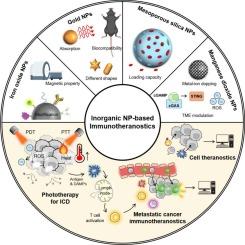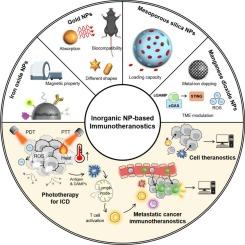基于无机纳米粒子的癌症免疫治疗
IF 23.5
1区 化学
Q1 CHEMISTRY, INORGANIC & NUCLEAR
引用次数: 0
摘要
基于无机纳米粒子(NP)的免疫治疗将诊断成像与治疗干预和免疫调节相结合,已成为癌症治疗的一种强有力的策略。这篇综述强调了多功能无机和混合纳米平台设计的最新进展,包括金、锰、氧化铁、介孔二氧化硅和c基系统、金属有机框架和量子点,它们共同递送化疗药物、免疫检查点抑制剂和免疫刺激分子。此外,这些平台在追踪转移传播和监测免疫细胞群(包括T细胞、自然杀伤细胞和肿瘤相关巨噬细胞)方面的应用也进行了探索。通过将纳米技术的新兴见解与最先进的免疫治疗策略相结合,本综述强调了个性化癌症治疗的发展前景。此外,它强调了免疫治疗平台在桥接诊断、治疗和免疫调节方面的转化潜力,以实现更有效、持久和个性化的临床结果。本文章由计算机程序翻译,如有差异,请以英文原文为准。


Inorganic nanoparticle-based cancer immunotheranostics
Inorganic nanoparticle (NP)-based immunotheranostics, which integrate diagnostic imaging with therapeutic interventions and immunomodulation, have emerged as a powerful strategy in cancer treatment. This review highlights recent advances in the design of multifunctional inorganic and hybrid nanoplatforms, including Au-, Mn-, iron oxide-, mesoporous silica-, and C-based systems, metal–organic frameworks, and quantum dots, that co-deliver chemotherapeutic agents, immune checkpoint inhibitors, and immunostimulatory molecules. Moreover, applications of these platforms in tracking metastatic dissemination and monitoring the populations of immune cells, including T cells, natural killer cells, and tumor-associated macrophages, are explored. By integrating emerging insights in nanotechnology with state-of-the-art immunotherapeutic strategies, this review highlights the evolving landscape of personalized cancer therapy. Furthermore, it underscores the translational potentials of immunotheranostic platforms in bridging diagnosis, treatment, and immunomodulation to achieve more effective, durable, and individualized clinical outcomes.
求助全文
通过发布文献求助,成功后即可免费获取论文全文。
去求助
来源期刊

Coordination Chemistry Reviews
化学-无机化学与核化学
CiteScore
34.30
自引率
5.30%
发文量
457
审稿时长
54 days
期刊介绍:
Coordination Chemistry Reviews offers rapid publication of review articles on current and significant topics in coordination chemistry, encompassing organometallic, supramolecular, theoretical, and bioinorganic chemistry. It also covers catalysis, materials chemistry, and metal-organic frameworks from a coordination chemistry perspective. Reviews summarize recent developments or discuss specific techniques, welcoming contributions from both established and emerging researchers.
The journal releases special issues on timely subjects, including those featuring contributions from specific regions or conferences. Occasional full-length book articles are also featured. Additionally, special volumes cover annual reviews of main group chemistry, transition metal group chemistry, and organometallic chemistry. These comprehensive reviews are vital resources for those engaged in coordination chemistry, further establishing Coordination Chemistry Reviews as a hub for insightful surveys in inorganic and physical inorganic chemistry.
 求助内容:
求助内容: 应助结果提醒方式:
应助结果提醒方式:


